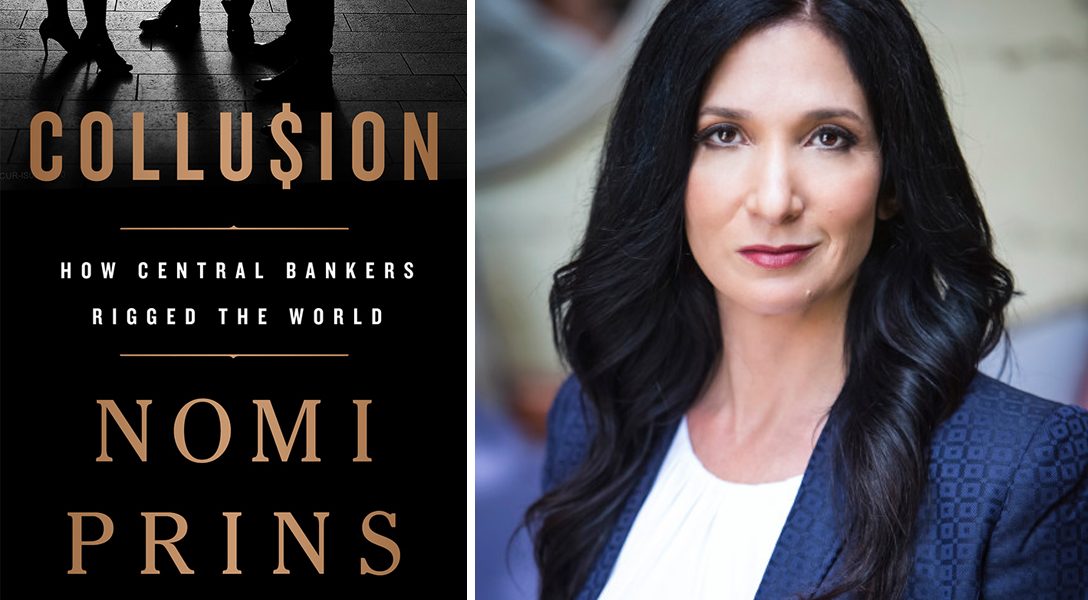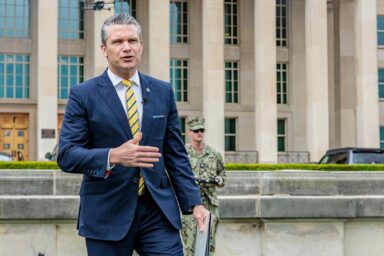How Central Bankers Rigged the World
Excerpt from ‘Collusion: How Central Bankers Rigged the World’
Mexico’s economy was flourishing in 2008 when it came crashing down as a result of the financial crisis. A new book tells the story of how greed in the US made the country suffer.
President Donald Trump likes to stress the need for a border wall to keep out gangs, “bad hombres,” and drugs coming to the US from Mexico. While the benefits of a physical wall are in doubt, probably few people would disagree that the US would be better off without importing narcotics, cartel members, and gang violence.
But did you ever wonder what Mexico gets from its big neighbor to the north that it would rather do without? Because the US does not just export Coca-Cola and fast food restaurants.
One unwanted “import” was the 2008 financial crisis, when Wall Street greed stopped Mexico’s surging economy in its tracks. And there is no wall for that.
— Introduction by WhoWhatWhy.
From Collusion: How Central Bankers Rigged the World, by Nomi Prins. (May 2018, Nation Books, an imprint of the Hachette Book Group)
MEXICO: There’s No Wall Against US Financial Crises
.
We’re in round one or two. This is a fifteen-round fight.
— Guillermo Ortiz, governor of the Central Bank of Mexico, World Economic Forum in Davos, Switzerland, January 23, 2008
In early 2008, Mexico boasted a large and thriving economy. After five years of steady growth, GDP had reached over $1.1 trillion by 2008 from $770.2 billion in 2002.1
As a gateway to Latin America, Mexico seemed destined to be a US subsidiary, not a partner. So it was doubly ironic when the United States “sneezed,” as it were. The recklessness of the US banking system and insufficient oversight by its key regulator, the Federal Reserve, caused a US financial crisis that temporarily inflicted a “cold” on one of its top three trading partners.
Having suffered several crises over the previous decades, Mexico had attempted to strengthen its financial stability by crafting a diverse economy that boasted an ambitious population keen on expanding cultural, business, and technological prowess. Mexico was also well positioned with a bounty of natural resources. Both a burden and a curse, the country relied heavily on the United States economically. This would prove to be one of the principal challenges that its central bank, Banco de México, faced when trying to act independently of the Fed.

Balancing its domestic responsibilities with the demands of the Fed put a strain on Mexico’s historic devotion to US policies. Both of Banco de México’s successively serving governors, Guillermo Ortiz and Agustín Carstens, reacted in different ways to the push from the Fed and pull from their country.
Ortiz was a man of fortitude, though. He had navigated several Mexican economic crises, including as minister of finance during the 1994 peso crisis. At the time, the New York Times called Ortiz “a bulldog administrator — short on style but tough enough to take on anyone who crosses him.”2 Prior to that, he was chief negotiator for Mexico during NAFTA (North American Free Trade Agreement) discussions and an executive director at the IMF from 1984 to 1988.3
Ortiz served two consecutive six-year terms at the helm of Banco de México, from January 1998 to December 2009. His father was a soldier during the Mexican Revolution. The military family background affirmed Ortiz’s stalwart personality.4 He led the central bank with a steady hand. He played by the rules of procedure, mixed with lessons of past experiences. That understanding cemented his decisions while giving rise to political tensions when the central bank’s monetary policy clashed with the government’s fiscal one.
His successor, Carstens, had a slightly more global establishment background and disposition. He was well versed in the ways of the International Monetary Fund and maintained personal friendships with its leadership. Carstens was more Americanized than Ortiz and was an avid Chicago Cubs fan from his graduate years at the Milton Friedman school of economics, otherwise known as the University of Chicago.
The Fed’s emergency money-conjuring policies stoked domestic power squabbles between the central bank and the government. Growth in Mexico’s international reserves had enabled the central bank to withstand adverse moves in capital markets like the US financial crisis. But the aspirations of the two men varied. Ortiz was a product of the Mexican establishment; he understood its power dynamics and how to navigate its political channels. For his part, Carstens (a confident, corpulent, well-connected multinationalist) believed the central bank was more tied up with the United States than either would have liked.

How It All Began
.
On a frosty day in late January 2008, Banco de México5 governor Guillermo Ortiz traveled to Davos, Switzerland, to address the World Economic Forum, a gathering of political-financial glitterati that included prominent politicians, central bankers, and private bankers. The topic was “The Power of Collaborative Innovation.”6 It was an optimistic banner given that financial innovation was about to breed financial crisis. Elite-speak often touts widespread collaboration, but the main power alliances call the shots. This exclusive gathering instigated the divide between emerging market countries and the United States.
The United States wasn’t in full crisis mode yet. Even though it remained in denial, other nations could not ignore the subprime market and toxic assets built upon this shaky foundation that was about to self-destruct. If they knew, there was no other option but to watch and develop a defensive strategy for the future. This meeting in the Swiss Alps stoked nothing short of an embryonic mutiny against the world’s major power.
Brazil was the nation chairing the G20 that year. At the Davos proceedings, Henrique Meirelles, head of Brazil’s central bank, presciently announced that leaders should focus on restoring financial stability in the wake of the US subprime crisis.7 Other officials concerned about the US banking system included European Central Bank president Jean-Claude Trichet and Malcolm Knight, chief executive officer at the Bank for International Settlements, the central bank of central banks. Though the looming crisis had not grabbed the public spotlight yet, impending system failure in the United States was already evident to these elites and any journalist paying attention.8
Nevertheless, everyone paid homage to the US financial system on the surface, even though beneath its veneer of success lay a cesspool of lurking financial dangers. But at one of the panels, Ortiz appeared to have other ideas. He was complimentary in characterizing the United States as “an innovator” in the financial markets. However, he took the opportunity to warn that such innovation was dangerous as well because “almost as a matter of definition, the market outpaces regulation.”
His panel was hosted by US media personality Maria Bartiromo.9 When asked to comment on credit freezes spanning the global markets, Ortiz quipped, “Well, I can say: ‘This time, it wasn’t us.’ ”10 Indeed, it was the US Fed failing to do its job properly.
In Mexico, concerns of an impending crisis were mounting. The United States could afford to act nonchalant. Mexico could not. Ortiz claimed that regulators “didn’t understand” the complexity of various financial instruments.11 He was right. But like other Latin American counterparts who voiced concerns or left rates high when the Fed didn’t, his stance would dampen his career trajectory and was largely disregarded by the major money conjurers. Yet, by breaking away from some of his larger fellow moneymakers, Ortiz sealed not just his professional fate but also in many ways that of Mexico’s economy.
Conditions in Mexico had already stumbled as a result of the economic recession that brewed in the United States since late 2007. In January 2008, the Hacienda y Crédito Público, Mexico’s Treasury Department, lowered its 2008 forecast to 2.8 percent from 3.7 percent growth in GDP. “That the US downturn will affect us — There can be no doubt,” Mauricio Gonzalez, president of Mexico-based analysis firm Grupo Economistas Asociados, told USA Today.12
Despite warnings of overheating financial innovation, there was a long-standing partnership between the Mexican central bank and the US Federal Reserve System. Shortly after the leadership gathering at Davos, the Mexican central bank head ascended to a high level of elite status: in February 2008, Ortiz was appointed to the advisory board for the Globalization and Monetary Policy Institute at the Federal Reserve Bank of Dallas, a group studying the impact of globalization on US monetary policy. The Dallas Fed had a tradition of such exchanges with Mexico’s central bank leaders, by virtue of the geography and because Mexican bankers were often connected to US elites. Their alliances ran through academic institutions, American boards of directors, and government relationships.
Ortiz’s appointment was a culmination of decades of collaboration with his US counterparts. “I have known Guillermo Ortiz for over 30 years,” said John B. Taylor, advisory board chairman and Mary and Robert Raymond Professor of Economics at Stanford University. “He brings unparalleled skills, experience and knowledge about central banking and its global dimensions.”13 Legacy connections proved critical in driving coordinated monetary policy.
Ortiz’s personal ties with the United States were extensive. He had received his PhD at Stanford University. In 1999, he became a member of the Group of Thirty, an elite economic and monetary affairs consultancy group comprising the public and private sectors and academia and based in Washington, DC.
Ortiz sensed the magnitude of shocks to befall the US banking system before US president George W. Bush, Treasury secretary Hank Paulson, or Fed chairman Ben Bernanke did. Bernanke, a so‑called expert on Depression-era economics and crashes in America, was readying a massive monetary intervention to eclipse that of the Great Depression of the 1930s. It would signal the birth of major collusive and conjured-money policy across oceans and borders.

On February 4, 2008, the White House submitted its budget to Congress. Bush proposed a $150 billion stimulus package and the highest military budget since World War II.14 He told Mexico’s president Felipe Calderón that his spending plans would also help Mexico’s economy.15
The United States needed Mexico to stay strong as its own center crumbled. In the age of globalization, stability mattered. What transpired on one side of the border was just as important as that on the other. Calderón took his cue from President Bush. On March 3, 2008, he announced a Mex$60 billion (US $5.6 billion16) stimulus package of tax breaks, utility rate discounts, and other spending programs to help Mexico weather the US slowdown.17 He assured businesspeople at the National Palace in Mexico City that his plan would “help make medium-term growth more dynamic.” His words soothed the impresarios seated in the historic locale, where Mexico’s leaders had assembled since the days of the Aztecs.
As events unfolded, so did financial chaos. It turned out that Bush was preparing for a monsoon with a $5 umbrella. Two weeks later, Bear Stearns, a New York–based investment bank in operation for eighty-five years, collapsed. The bank had leveraged too many complex securities stuffed with subprime mortgages. One CEO in particular who would benefit from Bear’s downfall was Jamie Dimon, a Class A board director at the NY Federal Reserve board.
On March 16, 2008, JPMorgan Chase got a $30 billion bailout from the Fed in the form of a guarantee to purchase Bear Stearns (my former firm). That figure was five times the Mexican stimulus amount. It was a sign of worse to follow. In a March 18, 2008, press release, the Fed noted, “Financial markets remain under considerable stress, and the tightening of credit conditions and the deepening of the housing contraction are likely to weigh on economic growth over the next few quarters.”18
That understatement opened the door for emergency monetary policies and greenlighted the blueprint for central bank collusion later on. The financial crisis was brewing, big Wall Street banks were frantically selling their worst assets to the least sophisticated investors. The Fed was slowly reducing rates in anticipation of a liquidity squeeze.
The world noticed.
About a month later, on April 22, 2008, the three NAFTA leaders, US president George W. Bush, Canadian prime minister Stephen Harper, and Mexican president Calderón, gathered in New Orleans to discuss the impact on Mexico of the impending financial crisis. As President George W. Bush’s numbers plummeted to the lowest of his administration, he told his counterparts, “Now is not the time to renegotiate NAFTA.” Bush emphasized, “Now is the time to strengthen free trade.”19 He believed the three were stronger together and that, with the banking system buckling, strength was definitely in order.
Harper, seeing the light at the end of the tunnel with the Bush administration, said Canada would consider a renegotiation of NAFTA — but with the next US president. He took the opportunity to say that his government would not want to restrict NAFTA’s major trade cornerstones. For Canada, that meant oil — it was the largest single supplier of oil to the American economy.
Calderón concurred: “This is the time to strengthen and reinvigorate this free trade agreement among our three countries…. We talked a lot about the NAFTA, and of course we agreed that this is not the time to even think about amending it or canceling it.”20
During the press conference, a reporter asked Bush how deep and how long the US economic recession would be and how it would affect Mexico.21 His response was, “I — we’re not in a recession, we’re in a slowdown… I’m probably the most concerned about the slowdown… . That’s why we passed … a significant pro-growth economic package.”
Calderón had also passed a growth package in Mexico. As Bush said, “The President is plenty capable of handling reform… And he’ll do what he thinks is right for the country of Mexico.”22 The United States didn’t interfere much with Mexico, as long as it stayed in line with what the United States wanted it to do. In the eyes of American policymakers, if Mexico was to succeed, it would be because of the US government. However, if it was to fail, it would be because it remained obstinate to US guidance.
Related: Getting Away Clean — Why Guilty Bankers Rarely Do the Perp Walk
Endnotes
.
1. “Mexico: GDP (Current US$): 2002–2009,” World Bank, accessed September 6, 2017, https://data.worldbank.org/indicator/NY.GDP.MKTP.CD?end=2009&locations=MX&start=2002.
2. Anthony DePalma, “Dogged Doctor for Mexico’s Morass,” New York Times, December 31, 1994, www.nytimes.com/1994/12/31/business/dogged-doctor-for-mexico‑s‑morass.html.
3. “Current Member Biography, ‘Guillermo Ortiz,’ ” Group of Thirty, accessed September 6, 2017, https://group30.org/members/bio_current/ortiz.
4. “Personalidades: Guillermo Ortiz Martínez, gobernador de Banxico,” Es Mas, accessed September 6, 2017, https://web.archive.org/web/20120716192333/www.esmas.com/ noticierostelevisa/biografias/406198.html.
5. The Bank of Mexico is the Central Bank of Mexico, also referred to as “BANXICO.”
6. World Economic Forum, www3.weforum.org/docs/WEF_AM08_Report.pdf. (This section of the website is unavailable.)
7. Thomas Atkins and Mike Dolan, “Bank Rules under Fire After Losses and Scandal,” Reuters, January 26, 2008, www.reuters.com/article/us‑davos-baselii-idUSL2668610220080126.
8. Nomi Prins, It Takes a Pillage (Hoboken, NJ: Wiley, 2009).
9. Then at CNBC.
10. “Mexico’s Ortiz Sees Risk in Overregulating,” Davos Live (blog), Wall Street Journal, January 26, 2008, https://blogs.wsj.com/davos/2008/01/26/mexicos-ortiz-sees-risk‑in‑overregulating/.
11. Ibid.
12. Lisa J. Adams, “Seeing US Slowdown, Mexico Cuts Growth,” USA Today, January 30, 2008, https://usatoday30.usatoday.com/money/economy/2008‑01‑30‑1083465555_x.htm.
13. “Banco de México Governor Ortiz Joins Dallas Fed’s Globalization Institute Advisory Board” (press release), Federal Reserve Bank of Dallas, February 14, 2008, https://www.dallasfed.org/news/releases/2008/nr080214.aspx.
14. Brian Naylor, “Bush’s Final Budget Proposal: $3.1 Trillion,” NPR, February 4, 2008, www.npr.org/templates/story/story.php?storyId=18672648.
15. “Bush Says US Spending Plans Will Help Mexico,” Reuters, February 5, 2008, www.reuters.com/article/bush-mexico-idUSN0521809020080205.
16. In 2008 dollars.
17. Mary Swire, “Mexican Government Unveils USD5.6bn Stimulus Package,” Tax-News, March 5, 2008, URL
18. “FOMC Statement” (press release), Board of Governors of the Federal Reserve System, March 18, 2008, www.federalreserve.gov/newsevents/press/monetary/20080318a.htm.
19. Frank Newport, “Bush Job Approval at 28%, Lowest of His Administration,” Gallup, April 11, 2008, www.gallup.com/poll/106426/bush-job-approval‑28‑lowest-administration.aspx.
20. George W. Bush, “The President’s News Conference with President Felipe de Jesus Calderon Hinojosa of Mexico and Prime Minister Stephen Harper of Canada in New Orleans,” American Presidency Project, April 22, 2008, www.presidency.ucsb.edu/ws/?pid=77159.
21. “Bush Praises Nafta Treaty,” CNBC Times Video, April 22, 2008, www.nytimes.com/video/business/1194817111807/bush-praises-nafta-treaty.html.
22. Bush, “The President’s News Conference with President Felipe de Jesus Calderon
What do you think? Please comment below.
Related front page panorama photo credit: Adapted by WhoWhatWhy from earth (Tom Magliery / Flickr – CC BY-NC-SA 2.0).



